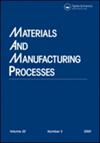工艺参数对铸铝合金异种搅拌摩擦焊接接头影响的研究
IF 4.7
2区 材料科学
Q2 ENGINEERING, MANUFACTURING
引用次数: 0
摘要
摘要铸造合金因其高比强度、低孔隙率、优异的流动性和可加工性,在汽车和航空航天领域的工业应用中找到了合适的就业机会。本研究的重点是在不同工艺参数下的铸造铝合金(AA356和AA2014)的搅拌摩擦焊接,即工具销形状(圆柱形,锥形,方形和螺纹圆柱形),刀具速度(1800-2100 rpm)和刀具进给(5-20 mm min - 1)。本文的新颖之处在于运用L16正交设计,结合方差分析、灰色关联分析、模糊逻辑系统和人工神经网络等方法来考虑铸造接头的焊接质量。研究涵盖了显微组织分析和晶粒尺寸估算。在方差分析的基础上建立了回归模型。2100 rpm、10 mm min - 1和螺纹圆柱体形状是影响极限拉伸强度和显微硬度的主要因素。方差分析和灰色关联分析的结果是一致的。模糊逻辑的结果显示,在灰色关联度方面有很大的改善。人工神经网络的结果为对所选刀具销形进行方差分析提供了合理依据。关键词:异种合金搅拌摩擦焊灰色关联分析模糊逻辑人工神经网络披露声明作者未发现潜在利益冲突本文章由计算机程序翻译,如有差异,请以英文原文为准。
An investigation of process parameter influences on dissimilar friction stir welding of cast aluminum alloy joints
ABSTRACTCast alloys find suitable employability in industrial applications favoring automotive and aerospace sectors owing to their high specific strength, low porosity, excellent fluidity, and machinability. The present study focuses on friction stir welding of cast aluminum alloys (AA356 and AA2014) with a varied range of process parameters, namely, tool pin shape (cylinder, cone, square, and threaded cylinder), tool speed (1800–2100 rpm), and tool feed (5–20 mm min−1). The novelty of the present work spotlights/features the implementation of L16 orthogonal design with the analysis of variance, grey relational analysis, fuzzy logic system, and artificial neural network approaches to contemplate the weld quality of cast joints. The microstructural analysis and grain size estimation is comprehended in the study. Regression models have been developed based on the analysis of variance. The prime factors favoring the ultimate tensile strength and microhardness were 2100 rpm, 10 mm min−1, and threaded cylinder shape. The findings from the analysis of variance and grey relational analysis are in concurrence with each other. The results of fuzzy logic showcased a substantial improvement in terms of grey relational grade. The results from the artificial neural network deliver rational evidence for the analysis of variance conducted on the selected tool pin shapes.KEYWORDS: Dissimilar cast alloysFriction Stir WeldingGrey relation analysisFuzzy logicArtificial neural network Disclosure statementNo potential conflict of interest was reported by the author(s).
求助全文
通过发布文献求助,成功后即可免费获取论文全文。
去求助
来源期刊

Materials and Manufacturing Processes
工程技术-材料科学:综合
CiteScore
9.00
自引率
22.90%
发文量
132
审稿时长
3.4 months
期刊介绍:
Materials and Manufacturing Processes deals with issues that result in better utilization of raw materials and energy, integration of design and manufacturing activities requiring the invention of suitable new manufacturing processes and techniques, unmanned production dependent on efficient and reliable control of various processes including intelligent processing, introduction of new materials in industrial production necessitating new manufacturing process technology, and more. Information is offered in various formats, including research articles, letter reports, review articles, conference papers, applied research, book and conference reviews, and entire issues devoted to symposia.
All submitted manuscripts are subject to initial appraisal by the Editors, and, if found suitable for further consideration, to peer review by independent, anonymous expert referees. All peer review is single blind and submission is online via ScholarOne Manuscripts.
 求助内容:
求助内容: 应助结果提醒方式:
应助结果提醒方式:


